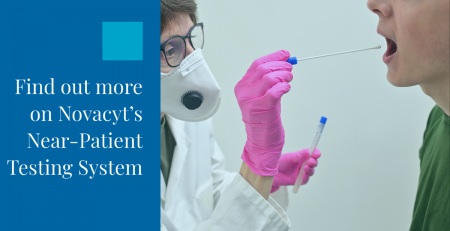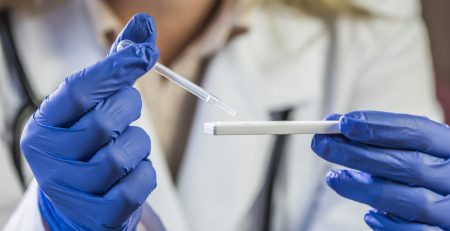SARS-CoV-2 Mutations – Cause for Concern?
The accumulation of genetic mutations is a normal part of viral evolution. Mutations change the sequence of the viral genome, creating different ‘variants.’ While some mutations might be silent, with no visible clinical effect, others might have implications for disease transmission, severity, reinfection potential, and immunity.
SARS-CoV-2 variants
A recently described clinically significant mutation has been termed N501Y, which put simply means that the amino acid ‘N’ at position 501 of the spike protein has been substituted for a ‘Y’. While this may seem innocuous, it in fact causes the virus to behave differently, including how tightly the spike protein binds to the ACE2 receptor – allowing for easier viral entry into human cells and an increase in viral transmission (1-3).

This key mutation has been observed in several SARS-CoV-2 strains, with a widespread geographical presence originating in the United Kingdom, South Africa, and Brazil. While the United Kingdom variant represented the original N501Y strain, the variant observed in South Africa carries two additional clinically important mutations in the spike protein called E484K and K417N. These mutations are thought to reduce antibody recognition and assist the virus in evading the immune system (4). Another variant cluster was reported to originate from Brazil, and as with the South African variant harbours the N501Y and E484K mutations, however it differs with a new K417T mutation. Similar biologically important fitness traits including immune evasion and rapid transmission are thought to be coded by these mutations (5).
Based on several independent analyses summarized in the SAGE meeting paper, there is a realistic possibility that infection with VOC B.1.1.7 is associated with an increased risk of death compared to infection with non-VOC viruses (6).
New variants – Do they matter?
While the advent of new variants may be a natural part of viral evolution, those that provide the virus with fitness advantages including faster transmission and host immune evasion are proving concerning to the scientific community. The potential impact of these new mutations compromising the efficacy of established diagnostic assays including RT-PCR and antigen detection tests has been raised. Most rapid antigen tests detect the SARS-CoV-2 nucleocapsid protein, meaning alterations in the spike protein will not affect this assay (7). Chief among these concerns are whether the new variants will weaken the effectiveness of vaccines (8). The mutations of greatest clinical concern (as described above) are concentrated in the segment of the viral genome coding for the spike protein the target to which the current vaccines build immunity to. However, due to the size of the spike protein, a large number of mutations would be needed for the virus to evade the vaccine – thus maintaining confidence that the vaccines will still work (4).
Overcoming the challenges of new variants with genomic surveillance
The World Health Organisation (WHO) has outlined various guidelines for local and national authorities to monitor emerging variants. These strategies include mass testing, contact tracing, and carrying out epidemiological and virological genomic surveillance (9). Genomic surveillance can increase the visibility of variants, and in turn identify trends to inform control methods including local lockdowns. This specialised surveillance involves analysing the sequences of SARS-CoV-2 from collected samples. The larger the sample pool, the more efficiently new variants can be identified, and transmission patterns will emerge.

To facilitate enhanced surveillance, the World Health Organisation recommend that countries maximise their sampling and sequencing where possible. They also state that this data should be made available in public databases. Tracking mutations in these databases helps researchers navigate the origins of the virus and better understand its spread. The genomic changes over time give unprecedented insights into how the virus is evolving and adapting, and how we can implement countermeasures to control its transmission on a global scale (10).
Novacyt’s world-leading surveillance platform allows us to closely monitor the emergence of new variants and analyse changes in SARS-CoV-2 to ensure our diagnostic kits can effectively detect the virus.
References
-
- ECDC (2020) Risk related to spread of new SARS-CoV-2 variants of concern in the EU/EEA. Available from: https://www.ecdc.europa.eu/sites/default/files/documents/COVID-19-risk-related-to-spread-of-new-SARS-CoV-2-variants-EU-EEA.pdf
- American Society for Microbiology (2021) B.1.1.7: What We Know About the Novel SARS-CoV-2 Variant. Available from: https://asm.org/Articles/2021/January/B-1-1-7-What-We-Know-About-the-Novel-SARS-CoV-2-Va
- Fiorentini et al. (2021) First detection of SARS-CoV-2 spike protein N501 mutation in Italy in August, 2020. The Lancet Infectious Diseases. DOI: https://doi.org/10.1016/S1473-3099(21)00007-4
- Covid-19: What new variants are emerging and how are they being investigated? BMJ 2021;372. DOI: https://doi.org/10.1136/bmj.n158
- Faria et al. (2021) Genomic characterisation of an emergent SARS-CoV-2 lineage in Manaus: preliminary findings. Available from: https://virological.org/t/genomic-characterisation-of-an-emergent-sars-cov-2-lineage-in-manaus-preliminary-findings/586/1
- UK (2021) NERVTAG note on B.1.1.7 severity. Available from: https://assets.publishing.service.gov.uk/government/uploads/system/uploads/attachment_data/file/955239/NERVTAG_paper_on_variant_of_concern__VOC__B.1.1.7.pdf
- UK SARS-CoV-2 lateral flow antigen tests: evaluation of VUI-202012/01 (2020) Available from: https://www.gov.uk/government/publications/sars-cov-2-lateral-flow-antigen-tests-evaluation-of-vui20201201/sars-cov-2-lateral-flow-antigen-tests-evaluation-of-vui-20201201
- Callaway (2021) Could new COVID variants undermine vaccines? Labs scramble to find out. Nature, 589:177-178
- WHO (2020) SARS-CoV-2 Variants. Available from: http://www.who.int/csr/don/31-december-2020-sars-cov2-variants/en/
- National Geographic (2020) How coronavirus mutations can track its spread—and disprove conspiracies. Available from: https://www.nationalgeographic.co.uk/science-and-technology/2020/03/how-coronavirus-mutations-can-track-its-spread-and-disprove













Leave a Reply